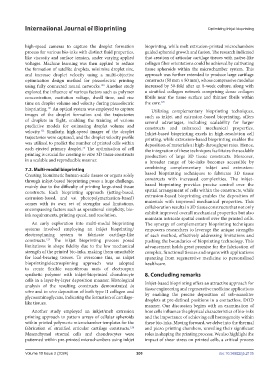Page 208 - IJB-10-2
P. 208
International Journal of Bioprinting Optimizing inkjet bioprinting
high-speed cameras to capture the droplet formation bioprinting, while melt extrusion-printed microchambers
process for various bio-inks with distinct fluid properties, guided spheroid growth and fusion. The research indicated
like viscosity and surface tension, under varying applied that creation of articular cartilage tissues with native-like
voltages. Machine learning was then applied to reduce collagen fiber orientations could be achieved by cultivating
the formation of satellite droplets, minimize droplet size, tissue spheroids within the microchamber system. This
and increase droplet velocity using a multi-objective approach was further extended to produce large cartilage
optimization design method for piezoelectric printing constructs (50 mm × 50 mm), whose compressive modulus
using fully connected neural networks. Another study increased by 50-fold after an 8-week culture, along with
120
explored the influence of various factors such as polymer a stratified collagen network comprising dense collagen
concentration, excitation voltage, dwell time, and rise fibrils near the tissue surface and thinner fibrils within
125
time on droplet volume and velocity during piezoelectric the core.
bioprinting. An optical system was employed to capture Utilizing complementary bioprinting techniques,
121
images of the droplet formation and the trajectories such as inkjet and extrusion-based bioprinting, offers
of droplets in flight, enabling the training of various several advantages, including scalability for larger
predictive models for estimating droplet volume and constructs and enhanced mechanical properties.
velocity. Similarly, high-speed images of the droplet Inkjet-based bioprinting excels in high-resolution cell
122
trajectories were captured, and the droplet velocity profile printing, while extrusion-based bioprinting enables the
was utilized to predict the number of printed cells within deposition of materials at high-throughput rates. Hence,
each ejected primary droplet. The optimization of cell the integration of these techniques facilitates the scalable
26
printing is crucial for creating in vitro 3D tissue constructs production of large 3D tissue constructs. Moreover,
in a scalable and reproducible manner. a broader range of bio-inks becomes accessible by
7.2. Multi-modal bioprinting combining complementary inkjet and extrusion-
Creating biomimetic human-scale tissues or organs solely based bioprinting techniques to fabricate 3D tissue
through inkjet-based bioprinting poses a huge challenge, constructs with increased complexities. The inkjet-
mainly due to the difficulty of printing large-sized tissue based bioprinting provides precise control over the
constructs. Each bioprinting approach (jetting-based, spatial arrangement of cells within the constructs, while
extrusion-based, and vat photopolymerization-based) extrusion-based bioprinting enables the deposition of
comes with its own set of strengths and limitations, materials with improved mechanical properties. This
encompassing factors such as operational simplicity, bio- collaboration results in 3D tissue constructs that not only
ink requirements, printing speed, and resolution. exhibit improved overall mechanical properties but also
maintain intricate spatial control over the printed cells.
An early exploration into multi-modal bioprinting The synergy of complementary bioprinting techniques
systems involved employing an inkjet bioprinting/ empowers researchers to leverage the unique strengths
electrospinning system to fabricate cartilage-like of each method, effectively addressing limitations and
constructs. The inkjet bioprinting process posed pushing the boundaries of bioprinting technology. This
123
limitations in shape fidelity due to the low mechanical advancement holds great promise for the fabrication of
strength of the printed bio-inks, making them unsuitable complex, functional tissues and organs with applications
for load-bearing tissues. To overcome this, an inkjet spanning from regenerative medicine to personalized
bioprinting/electrospinning approach was adopted healthcare.
to create flexible nanofibrous mats of electrospun
synthetic polymer with inkjet-bioprinted chondrocyte 8. Concluding remarks
cells in a layer-by-layer deposition manner. Histological Inkjet-based bioprinting offers an attractive approach for
analysis of the resulting constructs demonstrated in tissue engineering and regenerative medicine applications
vitro and in vivo deposition of both type II collagen and by enabling the precise deposition of sub-nanoliter
glycosaminoglycans, indicating the formation of cartilage- droplets at pre-defined positions in a contactless, DOD
like tissues.
manner. Our discussion begins with an examination of
Another study employed an inkjet/melt extrusion how cells influence the physical characteristics of bio-inks
printing approach to pattern arrays of cellular spheroids and the importance of achieving cell homogeneity within
within printed polymeric microchamber templates for the these bio-inks. Moving forward, we delve into the thermal
fabrication of stratified articular cartilage constructs. and piezo printing chambers, unveiling their significant
124
Mesenchymal stromal cells and chondrocytes were roles in shaping the printing process. We also highlight the
patterned within pre-printed microchambers using inkjet impact of shear stress on printed cells, a critical process
Volume 10 Issue 2 (2024) 200 doi: 10.36922/ijb.2135

